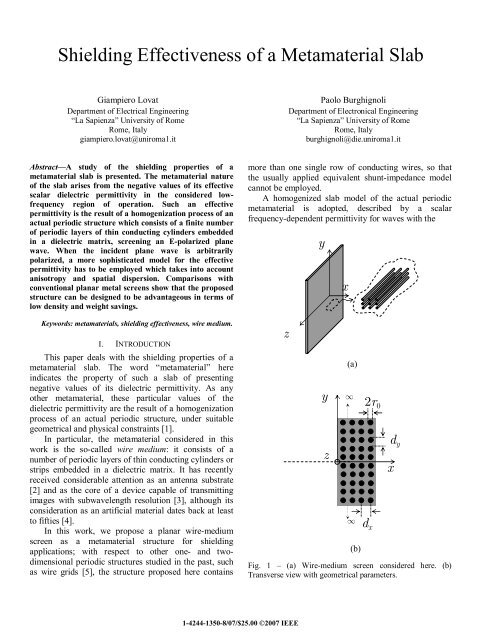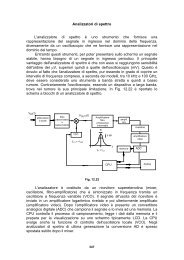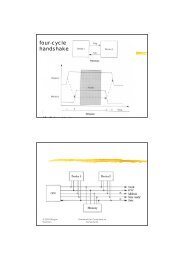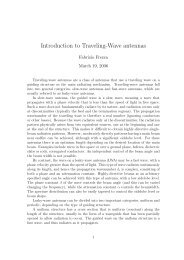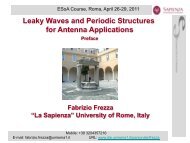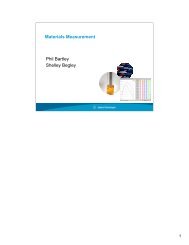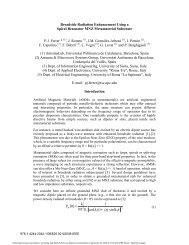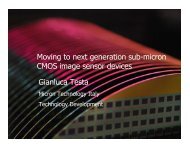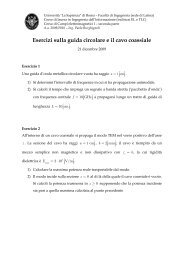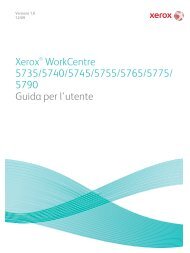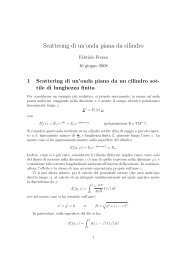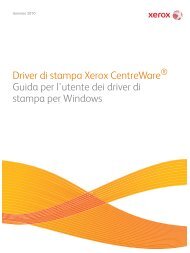Shielding Effectiveness of a Metamaterial Slab
Shielding Effectiveness of a Metamaterial Slab
Shielding Effectiveness of a Metamaterial Slab
Create successful ePaper yourself
Turn your PDF publications into a flip-book with our unique Google optimized e-Paper software.
Finally, in the homogenization process, a finitethickness h eff has to be associated to the homogeneousslab equivalent to the periodic structure, which takes intoaccount the fringing fields at the top and bottom layers<strong>of</strong> the structure. In particular, an equivalent thicknessequal to Nd will be adopted, in order to best match thereflection performance <strong>of</strong> the actual periodic structureand that <strong>of</strong> its homogenized model, as it will be shown inthe next sections.III. SHIELDING EFFECTIVENESSLet us thus consider a uniform plane waveimpinging on a homogeneous planar screen whichseparates two half-spaces filled with vacuum and whichis characterized by its relative constitutive parameters ε r ,µ r , its conductivity σ, and its thickness h. As is wellknown, with the considered type <strong>of</strong> electromagneticsource, its electric and magnetic shieldingeffectivenesses coincide and are equal toESE = 20logSE = 20logEdB lin twhere E i and E t indicate the electric fields <strong>of</strong> the incidentand transmitted plane waves, respectively. Thecalculation <strong>of</strong> the shielding effectiveness can easily beperformed by means <strong>of</strong> the usual transmission-lineanalogy, thus obtaining [9]whereRdBdBi(6)SEdB = RdB + AdB + MdB(7)= 20log R=20logA = 20log A=20log e( Z + Z )0 S4ZZjkxSh0 S⎛Z0 S − j2kxShMdB= 20log M = 20log 1−⎜ ⎟ eZ0 + ZS⎝2− ZThe impedances Z 0 and Z S depend on the TE or TMpolarization <strong>of</strong> the incident plane wave and on the angle<strong>of</strong> incidence θ i throughZZη η µ= , Z =TE 0 TE 0 r0 i ScosθkxSη kTM i TM 0 xS0= η0cos θ , ZS=ε rc⎞⎠2(8)(9)2 iwhere kxS = k 0 µ rεrc − sin θ and εrc = εr − jσ / ω(being k0 = ω µ 0ε0 and ω = 2π f ).When a planar metal screen is considered, theshielding effectiveness expression (7) can be furthersimplified (the propagation constant k xS is very large andpractically unaffected by the angle <strong>of</strong> incidence), so thatSElincησ32πf⎛⎜⎝πησf⎞c ⎟⎠0 0 exp h(10)When a lossless wire-medium screen is considered,characterized by an effective permittivity as in (1) andoperating below the plasma frequency, the followingexpression for the shielding effectiveness is obtainedinstead:SElin⎡ ⎤c 1 ⎢ 2π⎥ exp⎢N⎥ (11)4dfdd2πln ⎢ ln ⎥4r⎢0 ⎣ 4r⎥0 ⎦The explicit calculation <strong>of</strong> the shielding effectiveness <strong>of</strong> alossy wire-medium screen is just a bit more involved,since the imaginary part <strong>of</strong> the effective permittivity (asgiven in (4)) has to be taken into account.IV.NUMERICAL RESULTSA. Validation <strong>of</strong> the Homogenized ModelIn order to validate the adopted analysis technique,based on the homogenization <strong>of</strong> the metamaterial, fullwavesimulations have been performed <strong>of</strong> actual periodicwire-medium layers in free space with a commercials<strong>of</strong>tware based on the finite integration technique (CSTMicrowave Studio TM ) [10].In Fig. 2 a representative example is shown, for astructure constituted by N = 5 layers <strong>of</strong> perfectlyconducting wires with parameters d = 100 mm, r 0 = 0.1mm, ε rh = 1 (wires in vacuum). These values have beenchosen in order to obtain values <strong>of</strong> the shieldingeffectiveness not too large (lower than 80 dB in theconsidered frequency range), so avoiding inaccuracies due tonumerical noise.The homogenized slab has f p = 486 MHz, calculatedwith (2). The choice <strong>of</strong> the equivalent slab thickness is amore delicate matter. In fact, on one hand, the absence <strong>of</strong>a dielectric host slab containing the wires does not allowone to identify ‘natural’ interfaces between the
particular, while it monotonically increases withfrequency for the solid screen, it first increases and thendecreases in the wire-medium case, thus showing apossibly desirable selective property. We speculate that,by suitably modifying the internal geometry <strong>of</strong> themetamaterial, such frequency selectivity can becontrolled and possibly further enhanced.As a final remark, it can be observed that the wiremediumscreen would be completely transparent towaves with the electric field orthogonal to the wires. Inorder to shield normally-incident plane waves with anarbitrary polarization a double-layer screen can be used,with orthogonal wires in the two layers. This way, theoverall shielding effectiveness would be equal for anypolarization to the one considered above, i.e., the onecalculated for the single-layer screen for waves withelectric field polarized along the wire axis.V. CONCLUSIONAn analysis has been presented <strong>of</strong> the shieldingproperties <strong>of</strong> a planar metamaterial screen under planewaveexcitation. In particular, the actual periodicstructure, constituted by a periodic arrangement <strong>of</strong>several rows <strong>of</strong> parallel metal wires, has been modeledas a homogeneous isotropic medium exhibiting aplasma-like negative-epsilon behavior for waves withelectric field polarized along the wire axis.Full-wave results obtained with a commercials<strong>of</strong>tware based on the finite integration techniqueconfirm the validity <strong>of</strong> the approach based on thehomogenized model. Such a model allows for readilydesigning the geometrical characteristics <strong>of</strong> the actualperiodic screen in order to be advantageous with respectto conventional solutions based on solid metal plates.REFERENCES[1] R. E. Collin, Field Theory <strong>of</strong> Guided Waves, 2nd ed.Piscataway, NJ: IEEE Press, 1991.[2] G. Lovat, P. Burghignoli, F. Capolino, D. R. Jackson, andD. R. Wilton, “Analysis <strong>of</strong> directive radiation from a linesource in a metamaterial slab with low permittivity,”IEEE Trans. Antennas Propagat., vol. 54, pp. 1017–1030,Mar. 2006.[3] P. A. Belov and M. G. Silveirinha, “Resolution <strong>of</strong>subwavelength transmission devices formed by a wiremedium,” Phys. Rev. E, vol. 73, pp. 056607-1−056607-9,2006.[4] J. Brown, “Artificial dielectrics having refractive indicesless than unity,” Proc. IEE, vol. 100, pp. 51−62, May1953.[5] J. L. Young and J. R. Wait, “<strong>Shielding</strong> properties <strong>of</strong> anensemble <strong>of</strong> thin, infinitely long, parallel wires over alossy half space,” IEEE Trans. Electromagn. Compat.,vol. 31, pp. 238–244, Aug. 1989.[6] P. A. Belov, R. Marqués, S. I. Maslovski, M. Silveirinha,C. R. Simovski, and S. A. Tretyakov, “Strong spatialdispersion in wire media in the very large wavelengthlimit,” Phys. Rev. B, vol. 67, pp. 113103-1−113103-4,2003.[7] P. A. Belov, S. A. Tretyakov, and A. J. Viitanen,“Dispersion and reflection properties <strong>of</strong> artificial mediaformed by regular lattices <strong>of</strong> ideally conducting wires,” J.Electromag. Waves Appl., vol. 16, pp. 1153–1170, Sept.2002.[8] S. I. Maslovski, S. A. Tretyakov, and P. A. Belov, “Wiremedia with negative effective permittivity: A quasi staticmodel, ” Microw. Opt. Tech. Lett., vol. 35, pp. 47−51,Oct. 2002.[9] C. R. Paul, Introduction to ElectromagneticCompatibility, 2nd ed. Hoboken, NJ: Wiley, 2006.[10] CST Design Studio 2006, www.cst.com.


